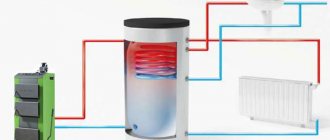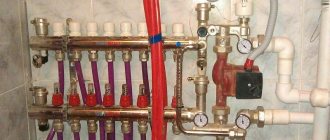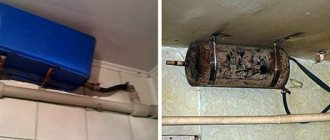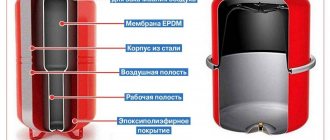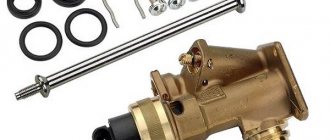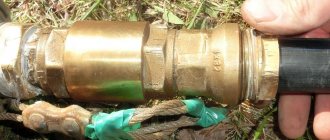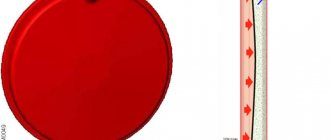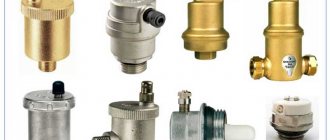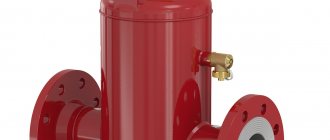| (Votes: 1, Rating: 5) |
Issues discussed in the material:
- Why do you need an expansion tank cap?
- How to choose an expansion tank cap
- How to modify the expansion tank cap
- Which expansion tank cap is the best?
Timely cooling is of great importance for a car engine. The most significant elements of the cooling system are usually considered to be the pump and radiator. But in this article we will talk about what role the expansion tank cap plays in the “organism” of the machine, how to choose the best one and, if necessary, troubleshoot problems.
Tasks of the expansion tank cap
Many motorists believe that the main function of the expansion tank cap is to prevent coolant from leaking out during vehicle operation. In reality, its purpose is more extensive; it plays an important role in the functioning of the engine.
A serviceable plug ensures the safety of many parts of the engine and its cooling system.
A running car engine gets very hot. This also heats up the coolant – antifreeze or antifreeze.
Part of the heat from the coolant is used to heat the vehicle interior, thereby reducing engine heating. When heated, the coolant expands simultaneously with an increase in pressure. The hotter the engine, the higher the pressure in the car's cooling system.
If the expansion tank were closed with a tight lid, ensuring the tightness of the entire cooling system, then high pressure inside the system would lead to rupture of pipes, tubes, hoses, failure of the radiator and other parts of the cooling system.
To eliminate such consequences, the expansion tank is closed with a special cap, which also plays the role of a valve.
The engines of various cars operate at certain temperature levels, depending on the type and design features of the internal combustion engine. The temperature range for most motors varies between +90…+100 °C. However, for normal operation of the engines of some cars, it is necessary to warm up to a temperature of +100...+130 °C.
We recommend
“Engine braking: how and why to do it” Read more
The named temperature range causes the coolant to expand by 20–30% of the initial volume. In this case, excess pressure arises in the cooling system. On average, the pressure can be 1.1–1.5 atm. Higher or lower values can cause certain problems, including the creation of a vacuum effect, compression of tubes, and breakdown of individual elements of the cooling system.
A good cap on the expansion tank containing coolant (antifreeze or antifreeze) prevents the occurrence of excessively high or, conversely, low pressure inside the cooling system and maintains its constant level.
Let us dwell in more detail on the design of the plug, as well as on the principles of operation of this irreplaceable element of the engine of almost any car.
We have already talked about the main function of the plug – stabilizing the pressure in the cooling system. Its second, no less important task is to retain the entire volume of coolant inside the tank. Therefore, the cork should fit tightly to the edges.
The functioning of the expansion tank cap is directly related to its design features, which consist of a built-in special valve. It is he who regulates the pressure inside the engine cooling system. This valve is located on the inside of the plug, i.e. inside the expansion tank. Modern cars are equipped with one such device, which simultaneously performs two functions - releasing excess pressure and pumping it up when the indicator drops to critically low values.
The operation of the expansion tank cap in a vehicle's engine cooling system depends on the type of cap. The design of the latter, which is installed on foreign cars, provides for the presence of one valve designed to both pump and release pressure inside the system.
At the same time, the design of the expansion tank caps of VAZ cars provides for the presence of two valves, one of which is designed to build up pressure, and the second to release it.
The expansion tank cap is equipped with the following valves:
- Protective – from high values.
- Vacuum - from low performance.
At normal pressure in the cooling system, both valves are closed and do not function. This situation is the norm.
However, the normal performance of the plug does not depend on the number of valves. The main importance is their timely opening and closing when the pressure in the system reaches critical values, no matter whether we are talking about high or, conversely, low pressure.
At normal pressure, which is within the permissible values, the plug valves are in a standby state, that is, they do not function. However, when the indicators go beyond the normal limits, the valve begins to either bleed off the pressure or pump it up, achieving normalization.
Cover device
It is important to understand that there is a locking element for expansion tanks on any car that has an internal combustion engine under the hood. And it doesn’t matter whether it’s diesel, gasoline or gas-powered.
Therefore, the problem with the failure of this unit can occur on any car, including such models as:
see also
The steering wheel creaks when turning: the main reasons, how to fix it
- Lada Kalina;
- Ford Focus;
- Gazelle Next;
- Daewoo Lanos;
- Volkswagen Passat;
- Lada Priora;
- VAZ 2110;
- Renault Logan;
- Opel Astra;
- VAZ 2114;
- Chevrolet Lacetti, etc.
You already understand that the cap serves not only to prevent coolant from pouring out of the tank. This is also a pressure regulator in the system.
A valve is hidden inside the lid, usually made of plastic. It is he who takes on such responsibility. The valve is immersed inside the expansion tank and, as necessary, pumps or releases excess pressure.
Before buying a new element, if you suspect the old one is broken, you can check it. A similar type of locking mechanism should be selected.
Please note that all modern foreign cars, in the vast majority of cases, have switched to single-valve caps for expansion tanks. That is, only one valve design is physically present. It just can perform two functions at once. While on domestic cars you can still find a pair of valves. Each of them is responsible for performing a corresponding function. Whether this is good or bad is difficult to judge. But the fact remains a fact.
The lid is activated only when an excess or deficit of pressure is detected in the system. Each car has its own temperature and pressure standards for the element to operate.
Signs of a faulty expansion tank cap
Unfortunately, some sellers offer car owners low-quality products, including plugs that can allow the pressure in the engine cooling system to increase to 1.3–1.5 atm or more, which significantly exceeds normal values.
Let's talk about several types of plugs designed for front-wheel drive Lada. Expansion tank caps for this car are produced by many manufacturers. Moreover, regardless of the difference in the color of the body, thread, “filling,” or the presence of inscriptions, the valves of the product must open when the pressure in the system reaches 1.1 atm.
If the plug is made poorly, then you may encounter a situation where excess pressure is released for an unnecessarily long time. Or, for example, the valve opens when the pressure reaches half the value, i.e. when it increases to 0.5-0.6 atm.
We recommend
“Liquid glass for a car: effective protection and attractive appearance” Read more
Malfunctions of the expansion tank cap are most often the cause of boiling of the coolant - owners of VAZ cars often encounter similar consequences. If the engine temperature is within the operating range, then it is obvious that the plug is not able to maintain the required pressure inside the cooling system.
A similar malfunction can be caused by another reason - a malfunction of the vacuum valve has led to air entering the car’s engine cooling system and the formation of an air lock, preventing normal circulation and, accordingly, cooling of the liquid. In the cold season, an air lock can lead to poor performance of the car's heater. In addition, you will have to constantly add coolant, since the increased pressure will drive it out through the joints between the fittings and the pipes put on them, as well as through the clamps.
The negative consequences of poor performance of the expansion tank cap are:
- rupture of low-quality or worn-out pipes (not only owners of VAZ cars may encounter such a problem);
- leaks in the main or heating radiator;
- thermostat housing rupture;
- expansion tank rupture.
To prevent these consequences, it is worth familiarizing yourself with the signs indicating unsatisfactory operation of the expansion tank cap valve. We list the main ones:
- The appearance of smoke from the engine compartment is most often caused by coolant leaking out of the expansion tank and hitting the intake manifold, which is heated to a high temperature . The positive point in this situation is the normal temperature of the engine itself. This sign indicates a failure of the plug valve. A normally functioning valve releases pressure from the system when it reaches a certain value, but in some cases the release begins ahead of time, which leads to antifreeze or antifreeze splashing out of the expansion tank.
- Despite the engine overheating, the heater pumps cold air into the cabin . This situation is possible if the valve that controls low pressure in the engine cooling system breaks down. When it fails, air enters the system and air pockets occur, causing the power unit to overheat.
- The appearance of traces of coolant in the area of clamps, pipes or under the radiator indicates valve failure . Excess pressure from the system is not released, leading to the breakdown of clamps, rupture of tubes and damage to the radiator.
At the same time, it is not always possible to limit yourself to replacing only the expansion tank cap; in some cases, you will also need a new radiator, clamps, tubes, and seals. Sometimes too high pressure causes the expansion tank itself to rupture. In this case, you will have to change the entire system assembly.
Signs of trouble
Before checking the cover, you need to receive a signal that it has potentially failed and is no longer performing its functions.
The symptoms of a breakdown are rather indirect and can manifest themselves in the following form:
see also
How to pay a traffic police fine: choosing the best way
- Thick white smoke is pouring out from under the hood;
- the engine overheats, but the stove remains cold;
- breaks the clamps;
- breaks the cooling system pipes;
- the radiator seal is broken;
- ruptures the coolant reservoir;
- the tubes are compressed and do not allow coolant to pass through;
- the circulation of antifreeze through the system is disrupted, etc.
Smoke usually appears when the pressure exceeds the permissible values. But overheating with a cold heater indicates precisely a lack of pressure in the system. Here it will be useful to remind you of the material devoted to eliminating an airlock. I'll leave a link to it. Go ahead and read.
How to check the expansion tank cap
In some cases, it is worth checking the condition of the expansion tank cap of the engine cooling system yourself. However, we should not forget about the complexity of this operation, since the functioning of the element depends on the pressure inside the system.
It is not so easy to create the pressure necessary for testing in the makeshift conditions of your own garage. In this regard, if you suspect that the tank cap is faulty, it is easier to contact a car service center than to check its functionality yourself.
The car service center will diagnose the plug by subjecting the expansion tank cap to a certain pressure, pumped by special pumps. Thanks to this, it is possible to determine whether the lid valve opens and closes when the required values are reached, or whether the failed plug needs to be replaced.
However, you can independently check the functionality of the plug, although, of course, the results obtained will not be as accurate as when diagnosed at a car service center. If you are thinking about how to check the expansion tank cap, then below are instructions for you.
First of all, before starting the engine, you need to remove the cap from the expansion tank located in the engine compartment and carefully inspect it in good lighting. A serviceable plug should not have mechanical damage, such as chips, cracks, tears, abrasions, etc. Their presence will indicate a malfunction of the lid, which caused the appearance of characteristic symptoms.
If a visual inspection does not reveal any damage to the plug, it must be replaced, then start the engine and warm it up to operating temperature. Then you need to open the hood again and, wearing gloves so as not to get burned, begin to carefully unscrew the plug. This must be done in complete silence in order to hear the sounds that may arise during the process of unscrewing the plug.
If no sounds occur, then the plug is working. A whistling or hissing sound while unscrewing it will indicate that the lid valve does not work, despite the fairly high pressure inside the system. Excess pressure is contained by the cap because the non-functioning valve does not open.
Low pressure is checked in another way. With the plug tightly closed, the engine warms up to operating temperature, and then the condition of the thick hoses of the cooling system is checked. The failure of the expansion tank cap will be indicated by compressed hoses pressed inside. This situation occurs when the pressure inside the system drops below the required level.
You can use an alternative method to check the functionality of the plug, but it is not suitable for all cars, since cooling systems have design features and different access to hoses.
If it is not possible to inspect the hoses without dismantling individual elements of the system, you can try to do this in the following way. With the expansion tank cap open, it is necessary to strongly compress the hose and then tighten the plug. After this, the pinched hose is released. If the tube returns to its original volume, the valves are functioning normally.
If you discover a malfunction of the expansion tank cap valve, you will have to replace the failed element. That is, you will need to buy a plug identical to the one installed in the cooling system of your car and put it on the tank. If after this the system starts to work normally, it means that the problem was precisely the plug in the coolant tank.
Device, principle of operation of the tank lid
So, firstly, the cap tightly closes the tank to increase the pressure in the system. Secondly, its device allows you to relieve maximum pressure. The design of any cover includes:
- The body is mostly durable plastic. There is a hole in it to relieve pressure;
- A seal to prevent air from escaping prematurely at the connection;
- Valve - It basically consists of a spring and a plate that closes the outlet.
The spring-loaded valve plate prevents excess air from freely exiting the system. The resistance of this element is strictly calculated by the manufacturer. As soon as the pressure in the circuit exceeds the permissible value, the spring is compressed by the plate and the outlet opens.
In many lid models, in addition to the pressure relief valve, a vacuum valve is installed. It eliminates the need to open the reservoir when the engine is cold. When the coolant expands, excess air leaves the system, and when it cools, the volume begins to recover. However, when the valve is tightly closed, a vacuum is created in the line. This causes the plastic tank to become deformed and may burst faster. The vacuum valve ensures free filling of the system with air.
Why is it necessary to control the pressure in the cooling system so precisely?
The pressure in the line cooling the power unit is important. Thanks to it, antifreeze does not boil in a modern car. If there is atmospheric pressure in it, the volume of the working fluid will decrease faster due to the evaporation of water. Such a problem will require frequent replenishment of the lack of fluid.
Also, insufficient pressure will accelerate the boiling of the antifreeze even before the engine reaches its maximum temperature. What the operating temperature of the power unit should be is described in a separate review.
Repairing the old and modifying the new expansion tank cap
It is recommended to change the expansion tank cap once every few years - this will help avoid problems associated with its failure. It is also worth checking the coolant level in the reservoir from time to time. If it is systematically reduced, then the likelihood of overheating of the cooling system increases, and, accordingly, a decrease in the performance of the plug valves and other elements of the cooling system.
However, in some cases the plug requires repair. Due to the simple design of the tank cap, every car owner can carry out repair work. To repair the expansion tank cap valves, you must:
- Open the cap and remove it from the neck of the tank.
- Using a flat-head screwdriver, pry up and remove the rubber seal from the neck.
- Remove the spring.
- Use a flat-head screwdriver to pry and remove the valve device located under the spring (the second valve, if present, is pulled out in the same way).
- Remove dirt accumulated in the lid using a soap solution and cotton swabs.
- Carefully inspect the valves, spring and rubber seal. If there are no mechanical damages on them, it is necessary to reassemble the device in the reverse order.
- Return the cover to its place, tighten it, check whether the system is sealed and warm up the engine.
Sometimes you may encounter a situation where the newly installed cap does not work correctly, for example, it does not relieve excess pressure from the engine cooling system or is not able to bring the reduced pressure to the required values. In this case, you can modify the expansion tank plug yourself. Most often, VAZ car owners complain about new traffic jams. The main reason for malfunctions in the operation of plug valves is caused by the excessive cruelty of their springs.
Before you begin to modify the expansion tank cap, you must first disassemble it. This is done using pliers and a thin flat-head screwdriver. It is important to remember the location of the springs so that you can assemble the lid correctly later. After disassembling it, use wire cutters to shorten the springs. The large one (on the safety valve) is usually shortened by one turn, the small one by two.
The length of the second spring does not matter much, the main thing is that it can support the vacuum valve in the closed position and does not interfere with the outside air pressure of 0.03–0.1 atm. At the same time, the length of the large spring is significant. When shortening it, it is necessary to proceed from its rigidity and pressure, upon reaching which the safety valve is activated when checking the expansion tank.
We recommend
“What to do if the timing belt breaks, and how to avoid this in the future” Read more
After the springs have been shortened, you need to reassemble the coolant reservoir plug in the reverse order. Before you start operating the vehicle, check the operation of the engine cooling system.
How does an expansion tank work?
To create the required pressure with the engine running, the cover must provide a tight seal. The safety valve is responsible for reducing the pressure. If the pressure in the system exceeds 1.1–1.5 kgf/cm2, this valve should open. After the pressure drops to operating values, the valve closes.
There is also an inlet or vacuum valve installed in the lid. It supplies air to the cooling system. After stopping the engine, the coolant temperature decreases and the pressure in the system also drops. The volume of liquid in the tank decreases, which entails a drop in pressure in the system. This leads to space for air in the expansion tank. At a certain point, the pressure in the system becomes equal to atmospheric air pressure. If at this moment the coolant temperature is higher than the outside air temperature, its volume will continue to decrease.
As a result of all this, the so-called vacuum or rarefaction effect is created. Outside air will press on the system components. If one of the parts of the cooling system is leaking, air will end up inside it. This leads to the appearance of an air lock. After starting the engine, it can get into the expansion tank. But it is also possible that problems may arise in the normal circulation of fluid in the system. Sometimes this leads to engine overheating or problems with the heating system.
Air may end up in the cooling system due to leaks in pipes and other parts. To avoid this, the pressure in the system must be equal to atmospheric pressure, which is what the inlet valve is responsible for. It starts working if the vacuum reaches 0.03–0.1 kgf/cm2. This valve supplies the air that was released by the safety valve while the fluid was heating up. Due to this, the pressure in the system does not differ from atmospheric pressure.
The best caps for the expansion tank: an experiment on a UAZ car
Let's talk about the best tested expansion tank caps:
- NONAME – yellow plug, graphics similar to VAG plugs (steam and triangle with an exclamation mark inside).
- AutoPribor (AP).
- Febi 02269 (VAG).
- SWAG 99902269 (VAG).
- Toprun Hans Pries 103643 (VAG).
Let’s say right away that the VAG expansion tank caps do not fit the standard tanks of UAZ cars. Incompatibility is caused by thread pitch and diameter. In principle, you can try to screw the plug onto the neck, but you will not be able to achieve a tight seal. During testing using a pressure gauge, it was found that even with the VAG cap tightly tightened, the pressure in the system was zero.
On the Internet you can find reviews regarding imported plugs that they fit perfectly and screwed onto the neck. However, in this case, the fact that the plug is screwed onto the expansion tank does not mean that it is functioning properly. In the absence of pressure, however, the hoses will not flow, so the car owner believes that everything worked out as it should, and will never agree with the opposite opinion.
For example, the difference between the expansion tank caps from Febi and SWAG is only in their packaging, otherwise they are identical. But in order to install a VAG plug on the tank of a domestic car, you will have to work hard and change the internal structure of the plug.
When testing for excess pressure, we used a stand consisting of a new coolant tank for the UAZ, a pressure gauge, a compressor and hoses. The lower fitting of the tank, intended for both Euro-3 and Euro-4, does not have a hole, so when installing it on a car you will have to do it yourself.
So, let’s take a closer look at the actual testing of the expansion tank caps.
- The yellow NONAME plug with an exclamation mark can be installed on coolant tanks of domestic cars.
The plug sold without packaging does not contain any information. Outside and inside, the expansion tank plug is identical to the cap, the difference lies in the seals made of black rubber instead of white silicone.The soft black rubber from which the expansion tank cap seal is made is firmly glued to the plug; to remove the valve from the plug, you must use a screwdriver and also apply considerable force. The plug did not cope with the high pressure test; pressure was not pumped above 2 atm due to the danger of rupture of the expansion tank. Due to stuck rubber, the suction check valve did not open.
Conclusion from the testing results: the plug is just a blind plug with non-functioning valves. We strongly do not recommend installing such a plug on your car.
- Stub .
It differs from the NONAME plug in the presence of the inscription “AP” on the plug itself and on the valve body. The design differences are more significant: instead of black rubber, a white silicone seal is used, which retains its shape and elasticity at high temperatures. New UAZ cars coming off assembly lines are equipped with such devices.We recommend
“How to change windshield wipers on a car: we understand the design and manufacturers” More details
The non-return valve in the reservoir lid is functioning, you can blow it out with your mouth, applying some effort. The likelihood of air entering the cooling system when the power unit cools down is very low. The valve designed to relieve excess pressure is also operational. Using a compressor, the pressure in the tank could not be raised to more than 1.4 atm. After the compressor was turned off, the pressure in the engine cooling system dropped to 0.4 atm within a minute, after which its decrease stopped.Conclusion based on the test results: the expansion tank cap is suitable for UAZ cars with their not completely sealed SOD hoses. The plug will prevent the coolant from boiling and prevent excess pressure from occurring in the cooling system.
Then plugs from foreign manufacturers developed for the VAG concern were tested. The Febi and SWAG caps have a one-piece valve and are identical to each other, the TopRun cap is equipped with different valves.
- SWAG/Febi.
To use this plug for the UAZ expansion tank, you will have to insert its valves into a plug suitable for the design. During testing, we used the body from the yellow NONAME plug, pulled out the rubber band from it and obtained a valve cartridge.To install the cartridge, you need to use a utility knife or an emery wheel to reduce the outer diameter of its skirt, since it is larger in size than the recess of the plug. Otherwise, there is a possibility that the cartridge inside the cover will become skewed.
Now all that remains is to install the rubber band, and the expansion tank cap is ready for use.
The check valve functions perfectly and no effort is required to suck in air. The air bleeder also works perfectly; the pressure inside the system is maintained at 1.4 atm. It was not possible to achieve a higher value using a compressor, but it did not decrease even after 5 minutes.
The conclusion from the test results is as follows: for an engine cooling system that can withstand a pressure of 1.4 atm, this expansion tank cap will be a good solution. But the standard V-shaped coolant tank that comes with the UAZ will not be able to withstand such pressure for a long time without damage or cracks. However, if you replace the hoses on your car with silicone ones, install a durable expansion tank (like on the Volga/Gazelle/VAG) and a Bosh pump, then it will fit perfectly. You should not use a plug from standard SOD.
The plug with two valves has seals made of red silicone. To install it on a UAZ tank, you will have to transplant its insides into a suitable housing, reducing the outer diameter of the valve block. In addition, in the plug for the UAZ car, you will need to get rid of the interfering central protrusion.
Test results were mixed. The operation of the check valve is not ideal and requires some effort. Much more questions arose regarding the operation of the bleed valve; in addition, it made it possible to increase the pressure in the system to 2 atm.
Conclusion: since when using this plug the pressure in the SOD can exceed 1.4 atm, there is a high probability of rupture and cracks of the tank, leaks from under the expansion tank cap and hoses, etc.
The general conclusion from the test results: the most suitable expansion tank cap for UAZ vehicles is the product. It differs from fakes by the white seals visible through the holes in the plug body, as well as by the operation of the suction check valve. Of the four externally identical plugs presented in the auto shop, intended for UAZ/VAZ cars, only the AvtoPribor cover had a functioning valve. That is, when choosing this plug, the main attention should be paid to not buying a fake. We talked about the distinctive features of the original product a little higher.
Installing VAG plugs on domestic coolant tanks has certain nuances. When using a TopRun plug, you should be prepared for the possibility of an increase in pressure from the SOD to 2 atm, which can cause negative consequences, including rupture of the tank. The SWAG/Febi caps have excellent valves that keep the system pressure at 1.4 atm. However, long-term operation of the car at such pressure in the cooling system can cause drops of antifreeze or antifreeze in the area of \u200b\u200bthe connection of the upper silicone hose and the pipe carefully tightened with a power clamp. Subsequently, there is a possibility of cracks appearing in the expansion tank itself.
Verification procedure
Checking the functionality of the reservoir cap is not so easy, since it is necessary to create pressure, which is difficult. For this purpose, service centers use special devices with a pump and pressure gauge. This allows you to set the exact actuation values of the cover valves. Self-diagnosis is possible, but it is less accurate in terms of the result. However, the faulty part will be detected.
First, you need to unscrew the cover on a cold engine and inspect it: are there any cracks, chips, dents, ruptures in the sealing elements, wear and other defects. If the result is positive, you should move on to the next method of checking the expansion tank cap. Just need to tighten it first.
Now you need to start the engine and wait until it warms up to operating temperature. Then you need to quietly begin to unscrew the lid. If you hear the sound of escaping air, similar to the sound of a cap being unscrewed from a bottle of soda, then everything is in order - the part is working and maintaining pressure in the system. While the engine is still running, it is worth inspecting the thick hoses for signs of being pressed inward. If this is the case, then one of the valves is not doing its job.
How can I check the expansion tank cap differently? You can also do this (preferably also on a cold engine): unscrew the cap, then squeeze some thick hose with your hand and then screw it into place. Now you can remove your hand and observe: the hose takes its original shape - everything is in order, otherwise it is better to replace the cover. Only this method cannot always be used due to the design features of the power unit of different cars and the location of the hoses.
What car enthusiasts say about expansion tank caps
- Expansion tank cap for Lada cars . – The best plugs are produced by the Vladimir plant, they are of high quality and are sold in packaging. The plug is able to maintain the required pressure. In addition, the price of the expansion tank cap was about 40 rubles; buying the rest, even German ones, can be called throwing money away.
- G8 plug for all models.
– The standard plug quickly melted, the air no longer came out. I tried the LUZAR cork, the result was the same. The listed lids also melted. But the plug from the “eight” showed itself to be excellent, I don’t know whether it melts or not, I haven’t looked at it for a long time.I installed a plug from AUDI for my sister, it functions perfectly and does not melt.
- Neck preparation .
– Having installed a new expansion tank, I worked on its neck with a file. Before this, the plug did not tighten properly and bleed air. After 6 months of using the blue lid, there were no complaints.
